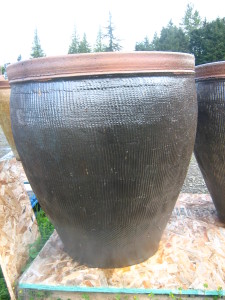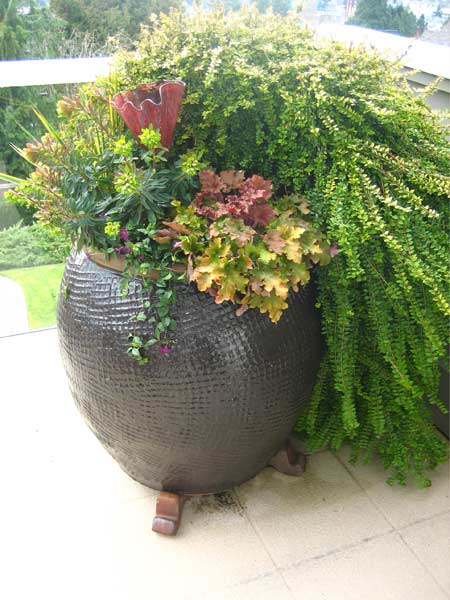Basics of Container Garden Design: Choosing a Container for Planting
 I like to think of container gardens as jewelry added to a nice outfit or the right pair of cuff links with a crisp dress shirt.
I like to think of container gardens as jewelry added to a nice outfit or the right pair of cuff links with a crisp dress shirt.
In fact, beautiful container garden arrangements have such a big impact on the overall picture that they are usually part of any discussion between client and landscaper.
Almost everyone wants to get to the fun part first – the plants. However, without proper preparation from the bottom up, your plants will fail to provide the aesthetic satisfaction you’d hoped for. This series of posts takes a look at what goes into the creation of a healthy, long-lasting container planting before a single plant is purchased and how to make a beautiful container planting more sustainable. Containers can be more sustainable than you think, although they are obviously not as permanent as a landscape planting. Much of it depends on how you prepare your container planting – and how you maintain it.
Basic elements for a good container planting:
- The physical container
- Soil
- Fertilizer
- Plants: annuals, perennials, shrubs, trees
- Water and maintenance
- Sustainability
Working in the Proper Scale for your Container Garden: The Physical Container
 When choosing your outdoor containers, bigger is usually better. If you only have space or money for one container, then try to make it the largest your space can comfortably accommodate. Beginning (and not so beginning) container gardeners make mistakes of scale most frequently of all. A pot smaller than 20 inches wide in the planting area will neither stand up to your home nor enable you to create much of a display. Too often I see a mass of very small containers scattered around a garden, which only creates a fussy effect. Groupings of small container gardens can make a statement if you have room, but you’ll still need large containers to anchor the arrangement.
When choosing your outdoor containers, bigger is usually better. If you only have space or money for one container, then try to make it the largest your space can comfortably accommodate. Beginning (and not so beginning) container gardeners make mistakes of scale most frequently of all. A pot smaller than 20 inches wide in the planting area will neither stand up to your home nor enable you to create much of a display. Too often I see a mass of very small containers scattered around a garden, which only creates a fussy effect. Groupings of small container gardens can make a statement if you have room, but you’ll still need large containers to anchor the arrangement.
Most containers I choose for my clients are made of ceramic or clay, which includes terra cotta. Why not plastic? I will reveal my aesthetic prejudice here: Plastic is usually very unattractive and doesn’t complement anything. If you are choosing plastic to reduce the weight of your containers, try one of the new lightweight styles. These include ‘Fiberstone, ‘Clayfiber,’ ‘Crescent Lightweight,’ ‘Rotomolded plastic’ or even lightweight metal containers. The number of impressive styles available to us in the Seattle area increases each year, including many more colors.
Speaking of style, carefully consider the style of your home and garden and choose your containers accordingly. While we all must  consider our budgets, there is no benefit to having a container that does not complement your surroundings. One way to tie into your home is to choose a planter that reflects a color used either in your home’s interior or its exterior.
consider our budgets, there is no benefit to having a container that does not complement your surroundings. One way to tie into your home is to choose a planter that reflects a color used either in your home’s interior or its exterior.
Make sure it’s frost proof.
If the supplier does not know, shop elsewhere.
How do I pick the right container for my garden?
I always say when choosing a container for planting you should like looking at the container even when it’s empty. Better to have one gorgeous, well-made vessel than a bunch of inexpensive containers that won’t last and are incapable of reaching the heights of a truly beautiful container planting.
